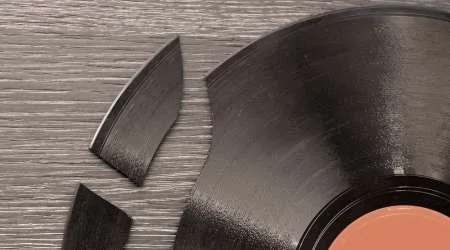The vinyl revival has been hugely exaggerated


While vinyl records have seen increasing sales, they're nowhere near becoming a dominant form of music consumption again.
Yes, we all thought vinyl records had died.
Right up until the 1980s, vinyl was by far the dominant physical format for popular music. In that decade, cassettes (more portable and usable in cars) began to rival vinyl. In the 1990s, CDs (more portable, more robust, and able to jump instantly to any track you wanted) became the main game.
Outside of dance clubs, vinyl looked like a very odd choice.
It doesn't look like an oddity now. Walk into a music store (presuming you can find one) and the vinyl LP display is likely to be as big or bigger than the CD collection. Classic albums are being re-released, hip young bands want to be pressed on vinyl. Blame hipsters, blame audiophiles, blame Adele, but vinyl appears to be back.
I'm a big fan of physical music (blame my age), so I don't wish any ill to vinyl collectors. But we need to be realistic. Vinyl's popularity has boomed, but from a tiny base.
If you want to own music (rather than download files or listen to streaming music services), it's a popular choice. But it's still not the most popular choice, not by a long shot. The much-maligned CD utterly dominates it, even as it declines.
That's not merely my opinion, it's what the figures show.
Let's look at wholesale shipment data for albums from the Australian Recording Industry Association (ARIA). If you look purely at vinyl shipments, the story is one of growth. Vinyl sales reached their nadir in 2007, with 18,000 units shipped, but by 2015 that figure had jumped to 374,000.
On a graph, that looks impressive.
However, that isn't the whole story. Put CD album shipments on the same graph and you can see that while CD sales are declining, their volume totally dwarfs vinyl.That's even clearer if you look at vinyl LP shipments as a percentage of CD shipments. In 2006, that figure was 0.06%.In 2015, it had risen to 3.30%. Yes, that's a big increase, but it still means that 24 CDs are selling for every LP.
Neither CDs nor vinyl are the main source of music any more, of course. If you want to hear new music, chances are you'll almost certainly do that through a streaming service like Spotify or Guvera or by downloading songs from a digital store like iTunes or Google Play Music. It's cheap, it's flexible, and you can access it anywhere.I don't expect either CDs or vinyl to die entirely. Both formats have dedicated fans who are happy to pay a higher price for a physical copy. Right now, despite all the hype, the number of CD fans is still a lot higher.
Angus Kidman's Findings column looks at new developments and research that help you save money, make wise decisions and enjoy your life more. It appears Monday through Friday on finder.com.au.
Picture: Shutterstock
